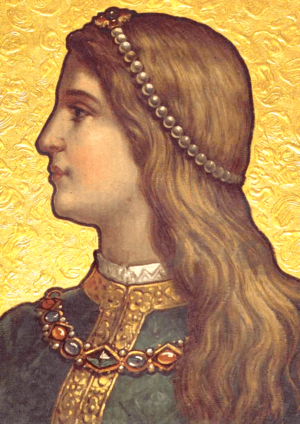Inês de Castro facts for kids
Quick facts for kids
Inês de Castro
|
|
|---|---|

19th-century depiction of Inês de Castro, on the ceiling of the Kings' Room, Quinta da Regaleira, Sintra, Portugal.
|
|
| Born | 1325 Galicia, Castile |
| Died | 7 January 1355 (aged 29–30) Coimbra, Portugal |
| Buried | Alcobaça Monastery |
| Family | Castro |
| Spouse | |
| Issue |
|
| Father | Pedro Fernández de Castro |
| Mother | Aldonça Lourenço de Valadares |
Inês de Castro (born 1325 – died January 7, 1355) was a noblewoman from Galicia, a region now part of Spain. She is famous for her love story with Prince Pedro of Portugal.
Their relationship was forbidden by Pedro's father, King Afonso IV. The sad events of her life, including her murder and Pedro's revenge, have made Inês de Castro a popular subject in art, music, and stories for centuries.
Contents
Who Was Inês de Castro?
Inês was the daughter of a nobleman named Pedro Fernández de Castro. Her mother was Aldonça Lourenço de Valadares. Inês came from a well-known family in both Galicia and Portugal.
In 1340, Inês arrived in Portugal. She became a lady-in-waiting to Constance of Castile. Constance had just married Pedro, who was the heir to the Portuguese throne.
A Forbidden Love Story
Prince Pedro quickly fell in love with Inês. This caused problems because Portugal already had a difficult relationship with Castile. Also, Inês's brothers became close friends and advisors to Pedro. This gave her family a lot of influence.
Pedro's father, King Afonso IV, did not like Inês's influence over his son. He hoped their love would fade, but it did not.
Constance of Castile, Pedro's wife, died in 1349. King Afonso IV tried to arrange new marriages for Pedro, but Pedro refused. He wanted to be with Inês.
The Tragic End
King Afonso IV had sent Inês away from the royal court in 1344. After many tries to keep them apart, King Afonso IV ordered Inês to be killed.
On January 7, 1355, three men went to the Monastery of Santa Clara-a-Velha in Coimbra. This is where Inês was living. They killed her.
Pedro Becomes King
Pedro became king of Portugal in 1357. He then searched for the men who had killed Inês. These men had fled to Castile. In 1361, Pedro captured two of them and had them publicly executed.
King Pedro also declared that he had secretly married Inês. However, his word was the only proof of this marriage. Later, during a time of crisis over who would be the next king (1383–85), some people argued that Pedro's marriage to Inês was not official. This argument helped another one of Pedro's sons, John, become King John I of Portugal.
Inês's Burial Place
Inês was buried at the Monastery of Alcobaça. Her tomb is still there, placed opposite Pedro's tomb. A legend says they were placed this way so that when they rise from their graves, they can look at each other.
Both tombs are beautifully carved with scenes from their lives. Pedro had promised that they would be together "until the end of the world."
Inês and Pedro's Children
Inês de Castro and Pedro I had four children. King Pedro I officially recognized them as his children on March 19, 1361:
- Afonso, who died shortly after birth.
- John, Duke of Valencia de Campos, who later claimed the throne during the 1383–85 crisis.
- Denis, Lord of Cifuentes, who also claimed the throne during the 1383–1385 crisis.
- Beatrice, who married a Spanish count. She became an ancestor of many Spanish monarchs.
Inês de Castro in Art and Stories
The story of Inês de Castro has been told in many plays, poems, and books. One famous example is The Lusíadas by Luís de Camões, a famous Portuguese poet.
Many other writers have also created works about her, including Aphra Behn and Mary Russell Mitford.
Her story has also inspired more than 20 operas and ballets. Some of these include:
- Ines di Castro by Niccolò Antonio Zingarelli (1798)
- Ines de Castro by Giuseppe Persiani (1835)
- Ines de Castro by Scottish composer James MacMillan (1996)
- Ines by Canadian composer James Rolfe (2009)
A Portuguese composer named Pedro Camacho created a special musical piece called "Requiem to Inês de Castro." It was first performed in 2012 to mark 650 years since Inês's body was moved to Alcobaça Monastery.
See also
 In Spanish: Inés de Castro para niños
In Spanish: Inés de Castro para niños
- Quinta das Lágrimas
Images for kids








